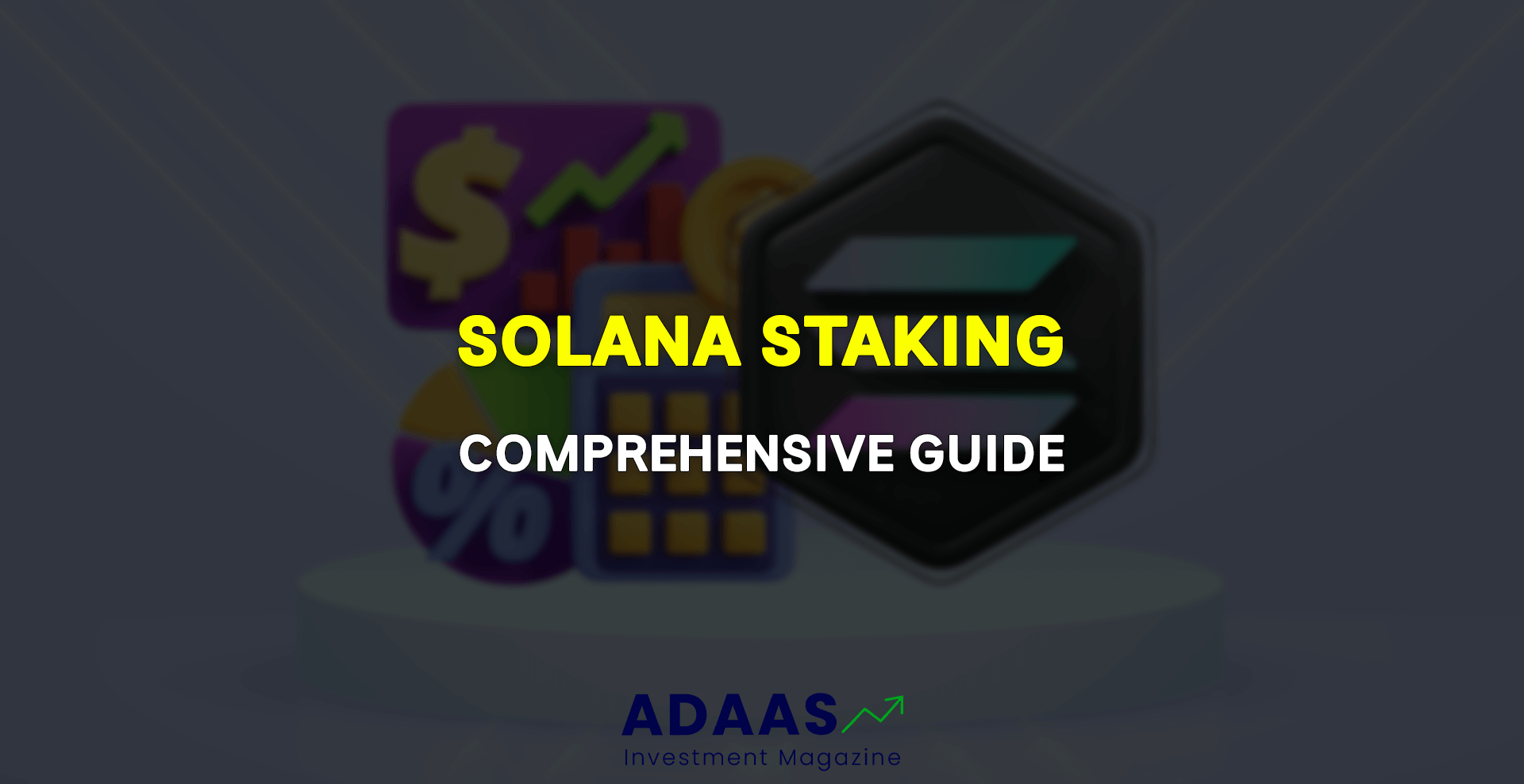Solana Staking Guide: How to Earn Rewards and Mitigate Risks
A Comprehensive Beginner's Guide to Staking Solana
By reading the article “Solana Staking Guide” published in Adaas Investment Magazine, you will be fully familiar with the important aspects of staking your Solana coins and what you need to consider while staking your coins in decentralized finance platforms! This level of familiarity can be enough when you need educational information about this topic.
This podcast is published for you!
Solana is a blockchain platform that has been gaining popularity due to its high-speed transactions and low transaction fees. The platform uses a proof-of-stake (PoS) consensus algorithm, which allows users to earn rewards by staking their tokens. In this article, we’ll delve into the world of Solana staking and explore the benefits and risks associated with it.
Solana is a decentralized blockchain platform that allows for fast and secure transactions. But we have to inform you Solana is currently governed by a small group of validators. As of March 8, 2023, only 10 validators control over 50% of the network’s stake. It was designed to address some of the scalability and transaction speed issues faced by other blockchain platforms. Solana’s unique consensus algorithm allows for high-speed transactions that can be processed in less than a second, making it one of the fastest blockchain platforms available. This speed is achieved through a combination of parallel processing, which allows the network to process multiple transactions simultaneously, and a unique time-stamping technique that helps to prevent transaction bottlenecks.
Staking is a crucial aspect of the Solana ecosystem. By staking their tokens, users help to secure the network and maintain its stability. Validators are responsible for processing transactions on the network and maintaining its security. In exchange for their work, validators receive rewards in the form of Solana tokens. Users can delegate their tokens to validators, who then share a portion of the rewards with them. By staking their tokens, users not only earn rewards but also contribute to the security and stability of the network.
The purpose of this article is to provide a beginner’s guide to Solana staking. We’ll cover the basics of staking, including how it works and how to stake Solana. We’ll also discuss the rewards and risks associated with Solana staking and provide strategies for mitigating these risks. By the end of this article, you’ll have a clear understanding of what Solana staking is and how you can benefit from it.
Table of Contents
What is Solana staking?
Staking is a process where users hold their tokens in a digital wallet and participate in the network’s consensus mechanism to help secure the network. In exchange for staking their tokens, users receive rewards in the form of additional tokens. Solana staking works in a similar way, but with some unique features and benefits.
Definition of Staking:
Staking in Solana involves holding SOL tokens in a digital wallet and delegating them to a validator. Validators are responsible for verifying transactions on the network and maintaining the network’s security. In exchange for their work, validators receive a portion of the transaction fees and a portion of the inflationary rewards distributed by the network. By staking their tokens, users can earn a portion of the rewards distributed to validators.
How Solana Staking Works:
Solana uses a hybrid PoS consensus mechanism, which combines a PoS system with a proof-of-history (PoH) system. In the PoS system, validators stake their SOL tokens to participate in the network’s consensus mechanism. In the PoH system, the network creates a verifiable sequence of events that can be used to confirm the order of transactions. This combination allows Solana to achieve high transaction speeds while maintaining security and decentralization.
To stake SOL tokens in Solana, users must first choose a validator to delegate them. Validators must meet certain requirements, such as having a minimum stake and running a node that is online and available 24/7. Once a user has chosen a validator, they can delegate their tokens using a digital wallet that supports Solana. Some popular wallets include Sollet, Ledger, and Exodus.
Benefits of Staking in Solana:
Staking SOL tokens in Solana offers several benefits, including:
1- High staking rewards – Solana offers some of the highest staking rewards in the industry, with APY rates averaging around 4-6%.
2- Low transaction fees – Compared to other blockchain platforms, Solana has very low transaction fees, making it an attractive option for users who want to transact frequently. However, the cost of transactions on Solana has increased in recent months. As of March 8, 2023, the average transaction fee on Solana is around $0.01.
3- Fast transaction speeds – Solana’s unique consensus mechanism allows for fast transaction speeds, with transactions processed in less than a second.
4- Network participation – By staking their tokens, users can participate in the network and contribute to its security and decentralization.
5- Flexibility – Solana’s staking system allows users to delegate their tokens to any validator they choose, giving them more control over their staking rewards and reducing the risk of centralization.
In summary, Solana staking is a process where users hold SOL tokens in a digital wallet and delegate them to a validator to participate in the network’s consensus mechanism. Staking offers several benefits, including high staking rewards, low transaction fees, fast transaction speeds, and network participation. By staking their tokens, users can contribute to the security and decentralization of the Solana network while earning rewards in the process.
How to Stake Solana
If you’re interested in staking Solana, here are the steps to get started:
1- Requirements for Staking:
Before you begin, you’ll need to make sure you meet the minimum requirements for staking on the Solana network. These include:
- A Solana wallet that supports staking
- A minimum amount of SOL tokens, which varies by staking platform
2- Choosing a Solana Staking Platform:
Once you have a Solana wallet and the required SOL tokens, you’ll need to choose a staking platform to stake your tokens. Some popular options include:
- Solana Beach
- Solflare
- Binance
When choosing a staking platform, be sure to consider factors such as fees, user interface, and reputation.
3- Setting up a Solana Wallet:
If you don’t already have a Solana wallet, you’ll need to set one up before you can stake your tokens. Some popular Solana wallets include:
- Sollet
- Ledger
- Phantom
- Exodus
Once you’ve created your wallet, be sure to securely store your private key and seed phrase.
4- Transferring Solana to the Staking Platform:
After choosing a staking platform and setting up your wallet, you’ll need to transfer your SOL tokens to the staking platform. This typically involves sending a transaction from your Solana wallet to your staking platform account.
5- Starting the Staking Process:
Once your SOL tokens are in your staking platform account, you can start the staking process. This typically involves selecting the amount of SOL you want to stake and confirming the transaction. Once your tokens are staked, you’ll begin earning rewards.
It’s important to note that the staking process may vary slightly depending on the staking platform you choose. Be sure to carefully read the instructions provided by your staking platform to ensure you follow the correct steps.

Rewards and risks of Solana staking
Rewards and risks are two sides of the coin when it comes to Solana staking. While staking can offer rewards, it also carries risks. Therefore, it is important to evaluate both the potential rewards and risks before deciding to stake Solana.
Explanation of rewards:
Solana staking rewards are the incentives paid to stakers for validating transactions on the network. The rewards are paid in Solana tokens and are distributed based on the staker’s share of the total tokens staked on the network. The more Solana tokens staked, the higher the rewards.
The rewards for staking Solana can vary depending on several factors, including the staking platform and the current network conditions. Currently, the average annual percentage yield (APY) for Solana staking ranges from 5% to 10%. This is comparatively higher than other staking options, such as Bitcoin, which currently offers an APY of around 1%.
Risks associated with staking Solana:
Staking Solana is not without its risks. Some of the risks associated with staking Solana include:
Market risk: The value of Solana tokens can fluctuate significantly based on market conditions. Therefore, stakers may face the risk of their staked tokens decreasing in value, resulting in reduced returns.
Smart contract risk: Smart contracts are used to manage staking on the Solana network. However, they can be vulnerable to attacks or programming errors, leading to loss of funds for stakers.
Centralization risk: The Solana network is secured by a limited number of validators, which could result in centralization of the network. In the event that these validators collude or act maliciously, it could result in a loss of funds for stakers.
Strategies for mitigating risks:
To mitigate the risks associated with Solana staking, stakers can employ several strategies, including:
Diversification: Stakers can diversify their staking portfolio by staking on multiple platforms and networks, reducing the impact of any single network’s risk on their overall portfolio.
Due diligence: Before staking, stakers should research the staking platform and validator to ensure they are trustworthy and secure.
Regular monitoring: Stakers should regularly monitor their staked Solana tokens and network conditions to identify any potential risks and take appropriate action to mitigate them.
In conclusion, Solana staking offers rewards, but it also carries risks. Stakers should evaluate both the potential rewards and risks before deciding to stake Solana. By employing strategies to mitigate risks, stakers can reduce their exposure to potential losses and maximize their staking rewards.
Top Solana Staking Platforms
Solana is a popular blockchain platform that offers a number of benefits, including high scalability, low fees, and a growing ecosystem of decentralized applications (dApps). One of the best ways to earn passive income from Solana is by staking your SOL tokens.
Staking is the process of locking up your SOL tokens in order to help secure the Solana network. In return for staking, you will earn a reward in the form of additional SOL tokens. The amount of reward you earn will depend on the staking platform you choose and the amount of SOL you stake.
There are a number of different staking platforms available for Solana. Some of the most popular platforms include:
Phantom Wallet: Phantom is a popular non-custodial wallet that supports Solana staking. It is easy to use and offers a number of features, such as staking rewards, built-in decentralized exchange (DEX), and support for dApps.
SolFlare: SolFlare is a web-based wallet that also functions as a staking platform. It is easy to use and offers a number of features, such as staking rewards, built-in DEX, and support for dApps.
Exodus: Exodus is a popular desktop and mobile wallet that supports Solana staking. It is easy to use and offers a number of features, such as staking rewards, built-in DEX, and support for a wide range of cryptocurrencies.
Ledger: Ledger is a hardware wallet that supports Solana staking. It is the most secure way to stake Solana, as your private keys are never exposed to the internet.
Binance: Binance is a popular cryptocurrency exchange that also supports Solana staking. It offers competitive staking rewards and a user-friendly interface.
When choosing a Solana staking platform, it is important to consider the following factors:
- Security: Security is the most important factor to consider when choosing a staking platform. Make sure to choose a platform that has a good reputation for security.
- Ease of use: Staking should be easy to do. Choose a platform that has a user-friendly interface and offers clear instructions on how to stake your SOL tokens.
- Staking rewards: The amount of staking rewards you earn will depend on the platform you choose. Make sure to compare the staking rewards offered by different platforms before making a decision.
Once you have chosen a staking platform, you can start staking your SOL tokens. The process of staking is usually very simple and can be done in a few minutes.
Conclusion
In summary, Solana staking provides an opportunity for investors to earn rewards while supporting the network’s security and decentralization. However, it is important to consider the associated risks and choose a reliable staking platform to ensure the safety of your investment.
Key Points:
- Solana staking involves locking up your SOL tokens to help secure the network and earn rewards.
- Staking requirements include a SOL wallet and a compatible staking platform.
- Top Solana staking platforms include Solflare, Sollet, and Ledger Live.
- Staking rewards are determined by the platform’s APY and can vary based on market conditions.
- Risks associated with Solana staking include market risk, smart contract risk, and centralization risk.
- Strategies for mitigating risks include diversification, due diligence, and regular monitoring.
Future Outlook for Solana Staking:
As the Solana ecosystem continues to grow and attract more users, the demand for staking is likely to increase. This could lead to higher staking rewards but may also result in greater competition and risk. Additionally, the development of new applications and use cases for Solana may further drive adoption and staking participation.
Final Thoughts:
Overall, Solana staking can be a lucrative opportunity for investors who are willing to do their research and manage their risks carefully. By choosing a reputable staking platform and diversifying their investments, investors can potentially earn consistent rewards while supporting the growth of the Solana network.

The End Words
At Adaas Capital, we hope that by reading this article you will be fully immersed in Solana Staking Process! You can help us improve by sharing this post which is published in Adaas Investment Magazine and help optimize it by submitting your comments.
FAQ
How much can I earn staking Solana?
The current staking rewards for Solana are around 5.5% APY. This means that if you stake 100 SOL, you can expect to earn around 5.5 SOL per year.
What’s the best way to stake Solana?
You can stake Solana on cryptocurrency exchanges, hardware wallets, or non-custodial wallets. The best way for you will depend on your individual needs and preferences. It is important to do your research and choose a reputable platform.
Can I lose my Solana while staking?
There is a very small risk of losing your Solana while staking. This risk is due to slashing, which is a penalty that can be imposed if you violate the staking rules. For example, if you try to unstake your Solana before the unbonding period has expired, you may be slashed.
Is staking Solana risky?
Staking Solana is a low-risk way to earn passive income. However, there are some risks to be aware of, such as slashing and market volatility.






I could reach this website anytime, fantastic!